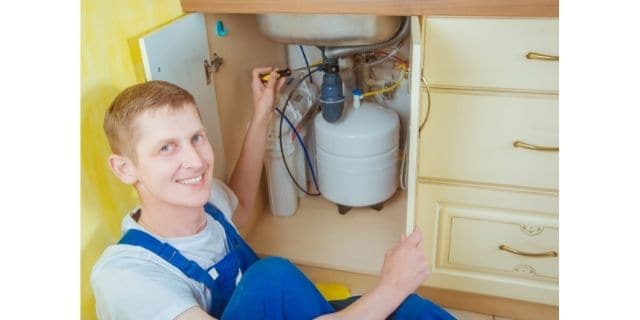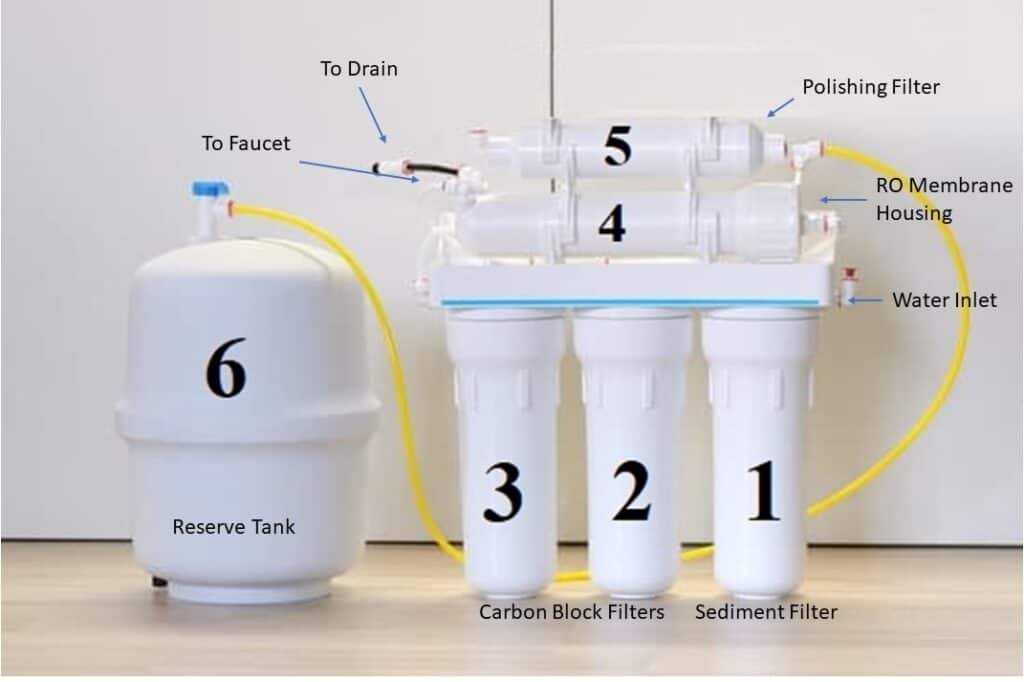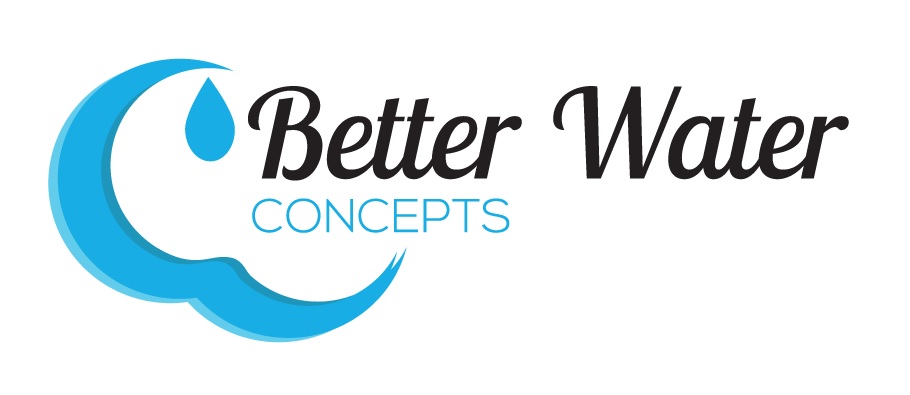Chemical Removal, Home Water Treatment
How Does a Reverse Osmosis Filter Work?
We're an affiliate
We hope you love the products we recommend! Just so you know, we may collect a share of sales or other compensation from the links on this page. Thank you if you use our links, we really appreciate it!
How a Reverse Osmosis Filter Works and How it Can Benefit You
We all want to drink the cleanest water possible. Reverse osmosis filters are one of the most popular and affordable ways to do this, but how does a reverse osmosis filter work?

Well, in short: It uses pressure and a semi-permeable membrane to separate contaminants from water.
In this blog post, we are going to look at how a reverse osmosis filter actually works and whether you should buy one for your home.
What is a Reverse Osmosis Filter?
Reverse osmosis filters are a popular type of water purification system. The reverse osmosis process uses pressure to push the liquid through a semi-permeable membrane before being ready to drink of put into a storage tank.
Reverse osmosis filters have uses in industrial or commercial settings because they can be used for a wide range of different contaminants found in potable water. However, many people purchase reverse osmosis filters for their home so they can enjoy pure drinking water.
Explain the Semi-permeable membrane in a reverse osmosis filter
The molecular structure of the membrane determines how well it can filter out contaminants. When water passes through a membrane, it will not allow large particles such as salts and other contaminates to pass through.
Reverse Osmosis uses the semi-membrane along with the water pressure in your plumbing already. To improve efficiency, some manufacturers of reverse osmosis systems will add a booster pump.
To understand why they add the pump, you need to understand the difference between osmosis and reverse osmosis.
In osmosis, a solvent (in our case water) separated by the semi-permeable membrane will move from one side of the membrane with a low concentration of impurities to the other side, where there are high concentrations of impurities. The driving force through the membrane is the difference in concentrations of impurities. When there is no longer any difference in concentrates, the osmosis stops. It is called reaching equilibrium.
In reverse osmosis, the direction of flow through the membrane is the opposite. Now the water is moving from a high concentration of impurities to a low concentration. As it does it leaves behind the impurities.
By adding a pump, the water can move through the membrane more easily.
Where do all the impurities the reverse osmosis filter removes end up?
As you might have guessed, the contaminants will build up on the supply side of the filter. In RO, there are two sides of the membrane and each side has a very different level of contaminants.
The Discharge Side: The discharge side of the filter contains purified water and is ready for either more filtration, storage or consumption. Most RO filters use a polishing filter (usually activated carbon) as the water leaves the membrane.
The Supply Side: The water that comes in contact with the membrane, water passes through it but the impurities do not. This leaves a high concentration of impurities. This water needs to be removed.
There is a waste line on the RO unit to carry the high concentrated impurities to the sewer.
How much water goes to the drain with RO?
You will soon find out that reverse osmosis systems are not very efficient. Theses systems waste a lot of water. Some RO filters on the market will waste 3 gallons to produce one gallon of purified water.
There are some systems that have improved their efficiency, so they waste only one gallon of water for every gallon of water purified.
What does Reverse Osmosis Remove?
RO can remove contaminants that can be harmful to our bodies, such as
- bacteria
- viruses
- pesticides and herbicides
- arsenic
- barium
- cadmium
- chromium
- copper
- lead
- fluoride
- nitrate
- and more
Do Reverse Osmosis Filters for Home Use Remove All Contaminants?
The reverse osmosis filter for home use will remove about 90% to 95% of the total dissolved solids (TDS) in your tap water. So, if your tap water has 300 ppm (parts per million) TDS after going through the RO unit, the TDS after will be between 15 and 30 ppm.

How the Water Flows through Reverse Osmosis Filter (Step by Step)
- Water flows from the supply line into the sediment filter. This stage filters out the suspended solids, dirt, sand, grit, etc to keep it from putting a strain on the rest of the system.
- And 3. Activated carbon filters. These filters work to remove chlorine, ammonia, chloramines and any organic compound before it gets to the RO membrane.
- The RO membrane. Water that passes through the membrane is purified and goes to the next stage. The water that has the concentrated contaminants is sent to the drain.
- The polishing filter. The polishing filter is another activated carbon filter used to clean up anything that might be present in the filtered water.
- After the water passes through the polishing filter, it is ready to drink or store in the storage tank.
NOTE: Not all Reverse Osmosis filters are the same. Some manufacturers will combine the sediment filters and the activated carbon filters. Some will add additional polishing filters. Still others will add a remineralization cartridge to add back some essential minerals like calcium or magnesium.
How to Choose a Reverse Osmosis Filter for Your Home
The key considerations for selecting a reverse osmosis system for your home include:
- Cost of the system – RO systems are rated by the gallons per day they can treat. This value, along with the number of stages, helps determine the cost of the system. A 50 to 75 gallons per day system should be sufficient for most households.
- Size of the system – Most reverse osmosis systems itself don’t take up any more space than many under sink water filtration systems. However, the storage tank can take up considerable space.
- Company reputation – Some companies manufacture inferior products, others produce fantastic products. While no company or product is perfect, you can tell a lot by reviews from their consumers.
Reverse Osmosis FAQ Section
How Much does a Reverse Osmosis Filter Cost?
The cost of this type of filter varies depending on how much you want filtered and where you buy it from. You can buy one for under $100 or spend over $600 for one, depending on your needs.
Do I need to hire a plumber to install a RO filter?
Some RO filters are pretty simple to install with basic tools and basic skills. If you are not sure, definitely call a plumber.
How often do I need to change the filters on a reverse osmosis system?
The RO membrane should last between 2 to 5 years. The sediment filters, activated carbon filters and the polishing filter should be changed more frequently. Be sure to read the instruction manual.
Should I get a whole house reverse osmosis filter?
Unless there is a specific need for a whole house system, the answer would be no. These systems cost in excess of $3000. It is more cost effective to have a dedicated faucet to get filtered water storing the RO unit under the sink.
Does reverse osmosis filter out fluoride?
Yes.
Does reverse osmosis filter out lead?
Yes.
Does reverse osmosis filter out bacteria?
Yes.
Does reverse osmosis filter pfas?
Yes.
Does reverse osmosis filter remove sodium?
Yes
Does reverse osmosis filter remove chlorine and chloramines?
No. But the activated carbon filter will remove it before it gets to the RO membrane.
Does reverse osmosis filter remove arsenic?
Yes.
Conclusion: How Does a Reverse Osmosis Filter Work?
Reverse osmosis filters are a great option for individuals or families who want to purify their drinking water without the hassle of having to buy bottled water. These filtration systems use a semi-permeable membrane and pressure in order to separate the contaminants from your tap water. The maintenance is also relatively simple. We hope this article helped answer any questions you might have about how reverse osmosis works!
